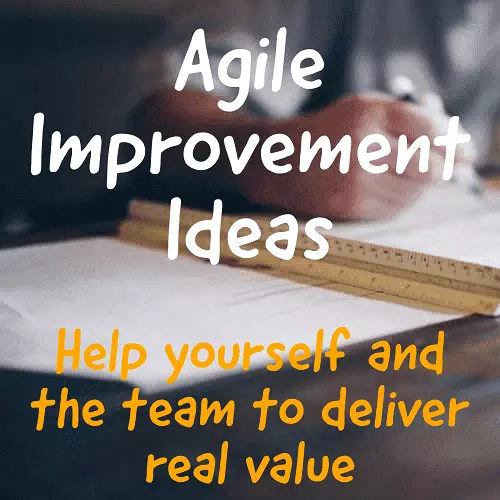
Discover the true power of Agile with these improvement strategies! Let’s dive into tangible practices for Agile improvement that can lead to remarkable changes. From tips that top-notch teams swear by to ideas that spark success, I’ve got you covered. While not exhaustive, these game-changing insights can unleash your team’s potential. Embrace Agile improvement and take your projects to new heights!
These ideas have helped agile teams of mine see marked improvement in consistency, ability to deliver value, and even the moral of the team. They are also great as a refresher or to learn Agile.
For effective agile improvement ideas, I include some concepts to consider. Solid agile fundamentals, boiled down into tangible concepts, are what I aim to share.
Remember with Agile, it is more important to take on continuous improvement. IE, Agile continuous improvement via small steps over time is much greater than small numbers of bigger steps. So pace yourself for the long haul. Learn Agile and you can deliver more in a sustainable way. With that, lets dive into some Agile.
- Agile Improvement Ideas — Practice Sharing The Outcomes Of The In Progress Work
- Collaborate And Build Shared Understanding To See Agile Improvement
- Have Frequent Review Of The Upcoming Work For Agile Improvement
- Have Frequent Retrospectives For Agile Improvement
- Flatten Decision Making Hierarchies And Empower Those Doing The Work
Agile Improvement Ideas — Practice Sharing The Outcomes Of The In Progress Work
Practice sharing outcomes of the in progress work in the daily stand up. Sharing the outcomes is all about getting the work to the next stage. IE, I completed XYZ, and now it is ready for test. Or, I completed 123, and we are ready to demo for users.
The daily stand up is not intended to be a status update. Team members are not there to report on what they are doing. They are there to collaborate. Keeping in touch, so the team knows of the work they are doing. Sharing outcomes, accomplishments, and what is stopping work helps team members collaborate on shared goals.
Additionally, the details of the work are not for the stand up. If further discussions are needed on details, teams should collaborate on that separately. That can be done in sessions that are more narrowed, having just team members needed.
Another benefit of sharing outcomes, is that team members better understand where work is at. This lets team members join together to help complete shared work. An agile concept commonly known as swarming. The team “swarms”, or joins up on the work, to help complete it faster.
Boosting Agile performance includes sharing outcomes. Sharing outcomes helps teams to get in a mindset of delivery. The team creates good habits around delivering software, based on the needed outcomes. This is a key item for Agile process improvement.
Collaborate And Build Shared Understanding To See Agile Improvement
Collaborate and build shared understanding of goals. This helps the team align on goals. The team builds shared understanding of the work to be done. Also build understanding of why you do the work. The benefits of doing said work. The best teams fill in the knowledge gaps and answer questions for each other. The team works in a fast paced environment. They need to be on the same page to meet goals.
Working without communication leads to duplication, rework, and fixes. Also, collaboration allows the team to build the best solutions possible. Teams that work together share ideas, and build off those ideas together.
By collectively creating solutions, you get something better than what the individuals could create. This leads to the team meeting the goals as best they can. Agile process improvement always includes communication improvement.
If you want to learn Agile, something that is fundamental to the methodology is that it is all about promoting teamwork and collaboration. That the team can build the best solutions, so let’s enable the team.
Have Frequent Review Of The Upcoming Work For Agile Improvement
The agile team needs to have sessions where they review upcoming work. You probably know this as sprint planning, or it can be backlog grooming. Terminology is not as important. The goal of having work ready to be started is the key factor.
The team has to work towards getting backlog work ready. You achieve this by spending time refining upcoming work. Refining, or grooming, is a process to review work. The team adds details to acceptance criteria. They identify dependencies to help order the work. They ask good questions and clarify the work. This lets the team continue building understanding and to help prioritize the work.
How often to review depends on the team and the complexity of the work. In my opinion, it is best to start with small meetings that happen weekly or every other week. Get in good refining habits, and then expand as needed to meet the work. One note on this, is that you don’t want to refine too much backlog work. Because, you may refine work that you don’t ever get to.
Have Frequent Retrospectives For Agile Improvement
You should have retrospectives often. The retrospective is traditionally a meeting to reflect on the sprint of work. The team looks back at what went right and what went wrong. Reflect not just on sprints, but on specific work or processes as well. Anything the team wants to improve on.
A retro is a great tool to lead that change. The retro formalizes a process of inspection and adaptation. The team uses the retro to discuss issues and problem solve. Letting the team come up with solutions to their issues. The retro leads to collaboration and innovation for the team. Use them to make improvements.
Also, Check Out The Modern Product Owner!
Flatten Decision Making Hierarchies And Empower Those Doing The Work
Flatten decision making hierarchies for the team. This means removing layers between the team and those making decisions. If you flatten decision making hierarchies, you let the team make the best decisions they can about the work.
The team is in the work and they are the best to decide on most things. This gives you better decisions on day to day questions. Removing that ability stifles creativity and innovation. It adds inefficiency to the process. As you end up waiting for key decision makers. Thus, flattening the decision making hierarchy thus gives you 2 things. First, you obtain better decisions overall. Second, you make decisions more quickly.
I also put high importance on this item, as something for Agile improvement ideas. Stifling a team in bureaucracy slows them down. It removes their ability to make decisions. Thus halts their ability to do good work.
Also, if you want to learn Agile, you must understand that it is about guiding ideas. At most a framework. But it is not a defined process. Defined processes are too rigid and don’t allow for the flexibility in the work that is needed.
Remember scope of the work
Keep to MVP of the product. This is the minimum viable product. Don’t expand scope unnecessarily. This is a practice and takes time, as a natural inclination is to add in new things as they are thought of when they make sense. But, that will slow down work and is not an Agile practice. Keep work minimal, and try to work in incremental and iterative chunks of work. New and additional things can always be done later on. Or even next up. But you need to finish the current work, deliver it, and then see what the next thing is.
Practicing this in Agile development is where you will get good business value. Focus is the name of the game in Agile process improvement. The team can’t do everything, so remembering to focus on top priority and the scope that is of top priority is huge.
Building software is more about building the right things than building all the things. Remember that if you want to deliver real business value. Prioritizing work becomes such an important part of your software development process. If you want to see Agile improvement, work on your prioritization and value assessment skills.
As Always, Practice An Open And Reflective Mindset
Not a specific tip like the 6 above. This is more about keeping an open mind. Also, being adaptive to changing needs. You create solutions to deliver the best work possible. Do not stick to rigid processes. Processes that hold back best solutions. Be adaptive and flexible to new ideas. Ideas for practicing an agile mindset includes learning.
Additionally, it includes adjusting to what suits your team. This is about reflecting and learning to make improvements. Some of these tips may help you, but some might already be working well for your team. For Agile process improvement, these are ideas for possible changes. Of course things could vary for your team. I am always open to a conversation. If you would like to discuss this in more detail. Ideas for Agile improvement are about improving at some key fundamentals.
So remember the values and principles of Agile if you really want to see Agile improvement! Practice good Agile continuous improvement to see tremendous gains over time.
Additional reading and books that give Agile improvement ideas

Also, check out a another great piece of information on Vertical Slicing is available here, to help with Agile improvement. If you want to learn, the various Agile improvement techniques compliment Vertical Slicing. Don’t forget the Agile Manifesto. It is the source for boosting Agile performance. Go right to the source to understand the values and principles. Another great resource on Agile ideas is Mountain Goat Software. Check out the blog and resources there.

